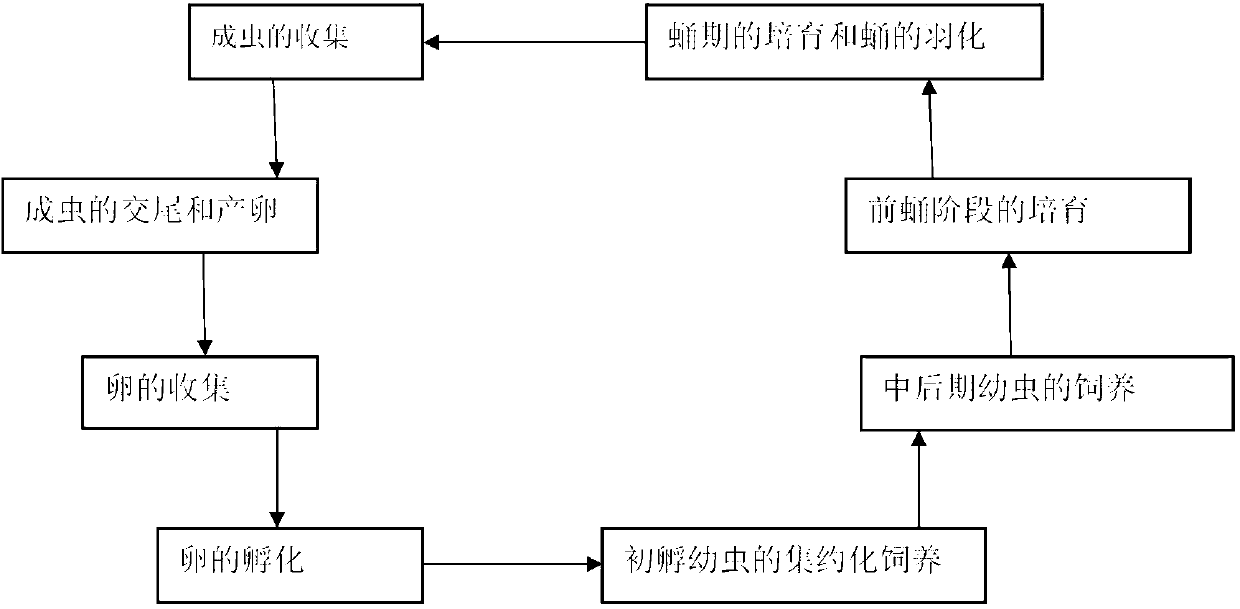Manual expanding propagation method and special equipment thereof for worm grass host insects
A Cordyceps host and special equipment technology, applied in animal husbandry, etc., can solve the problems of difficulty in cultivating host larvae, and achieve the effect of avoiding killing each other, avoiding mutual infection of diseases, and utilizing space
- Summary
- Abstract
- Description
- Claims
- Application Information
AI Technical Summary
Problems solved by technology
Method used
Image
Examples
Embodiment 1
[0021] Embodiment 1 The structure and method of use of Cordyceps host larva cultivation tray and emergence tray
[0022] The special equipment for the artificial propagation of Cordyceps host insects is named as the Cordyceps host larva cultivation tray in specific production. The Cordyceps host larva cultivation tray is composed of four parts: a box body 1, a moisturizing material, a partition device 2 and a box cover 3; wherein, the box body 1 is a box-shaped or disc-shaped structure with an upper opening, and the The bottom is horizontal, and a seepage groove 1-1 with strip grooves is arranged on the inner bottom surface. The seepage groove 1-1 can be composed of parallel strip grooves, or can be composed of multiple grooves intersecting.
[0023] There is a layer of filtering and moisturizing material on the inner bottom surface. The material can be plant fiber material, glass fiber material; it can also be a water-absorbing material made of cotton cloth or water-absorbing...
Embodiment 2
[0028] Example 2 Investigation of Cordyceps host insect artificial propagation method
[0029] 1. Collection of eggs
[0030] The collection of insect eggs is carried out under the environmental conditions between no cleanliness requirement and a cleanliness level of 300,000. The eggs laid by adults of Napialus hunanensis Chu et Wang and Gongga bat moth were collected respectively. The specific harvesting method is that in the harvesting area, the adults (or adults collected from the species rejuvenation area) that have emerged in each cultivation grid on the same day are placed in a supported mosquito net mating bed (made of gauze or It is made of materials that can be ventilated but can prevent adults from escaping), hang inside the mosquito net or place some things that adults can attach to in the egg box, such as green grass, branches with green leaves or bamboo branches, etc., hang the end of the mosquito net Place in the egg box. Place the mosquito net mating bed with...
Embodiment 3
[0046] Embodiment 3 Comparison of traditional indoor intensive cultivation of Cordyceps host insects and single isolated cultivation of Cordyceps host insects
[0047] The key to realizing the full artificial cultivation and semi-wild cultivation of Cordyceps lies in the feeding and cultivation of host larvae. The 3000 Gongga bat moth larvae collected in Example 2 were randomly divided into 3 groups; respectively named as single isolation culture group I, Intensive breeding group and wild stocking group.
[0048] The treatment of the single isolation culture group I is as follows: under the environmental condition that the cleanliness requirement is not lower than 100,000 grades, place the larvae in the Cordyceps host larva cultivation tray provided in Example 1 and rear them individually. Each larva lives in an independent space, and the larvae live on the moisturizing material and cannot meet each other. Adding water to the moisturizing material keeps the humidity at a quali...
PUM
 Login to View More
Login to View More Abstract
Description
Claims
Application Information
 Login to View More
Login to View More - R&D
- Intellectual Property
- Life Sciences
- Materials
- Tech Scout
- Unparalleled Data Quality
- Higher Quality Content
- 60% Fewer Hallucinations
Browse by: Latest US Patents, China's latest patents, Technical Efficacy Thesaurus, Application Domain, Technology Topic, Popular Technical Reports.
© 2025 PatSnap. All rights reserved.Legal|Privacy policy|Modern Slavery Act Transparency Statement|Sitemap|About US| Contact US: help@patsnap.com



